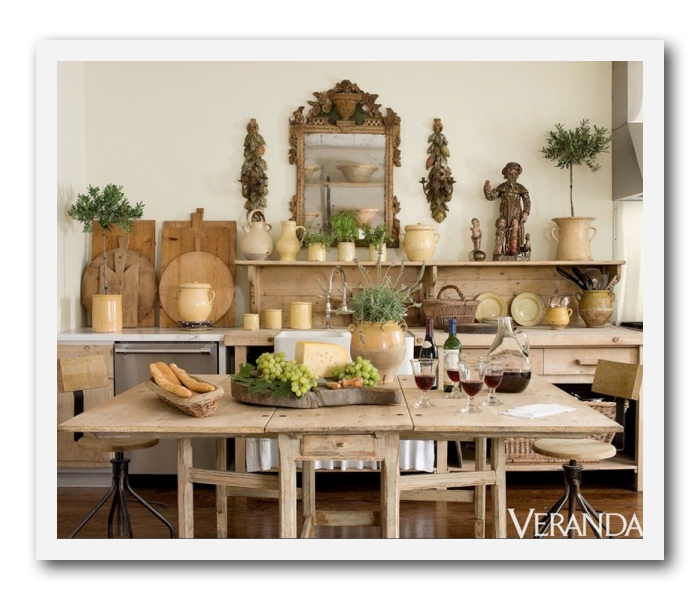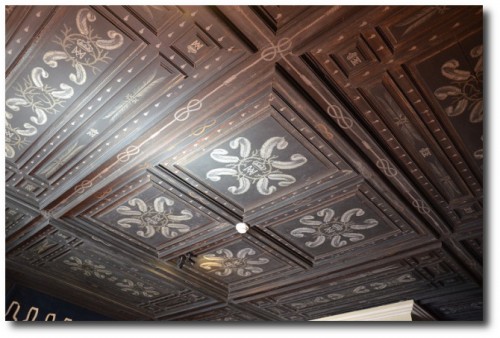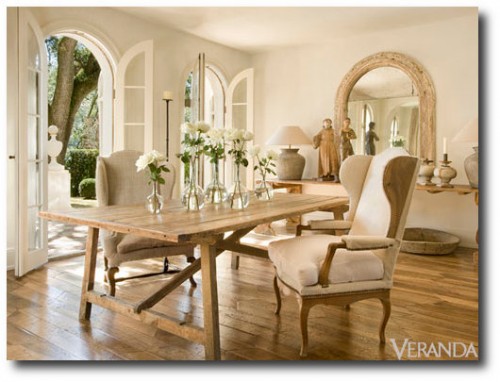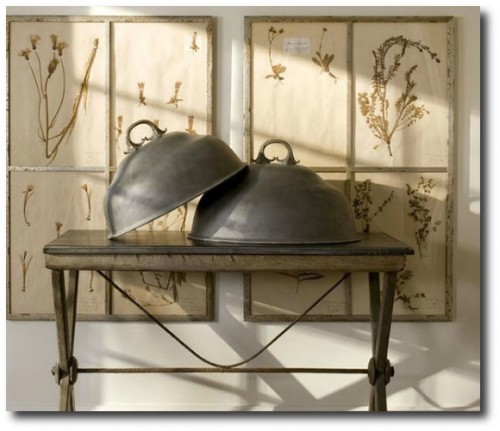
French Designer Jane Moore Gives Her Top 3 Tips She Designs Around


Veranda had an article asking European Designer Jane Moore her top tips for design. Here is what she said:
1. Tip From Jane Moore – The OPPOSITE EFFECT
Let your environment help you make decisions about your interior design.
” I have always lived in Houston, where it is very hot and humid. As a result, I always pick cool colors that come from nature—soft blues, greens, grays—because when I come in out of the heat, I want to be refreshed. ”
Why this design advice works is your outside environment plays a very major role in your life. If your missing the elements from the outside that you crave, bring them into the house which you spend the rest of your time. If you live in a cold climate, warmer accessories might be something to invest in. Perhaps velvet pillows in deep shades of rust instead of blue and green.
What do you think? Great tip?
2. Tip From Jane Moore – EDIT
As you mature in your life and design, edit to what you love the most, and remove the rest.
It can be hard to give up something that you spent a lot of money on earlier in your life, or a piece that is hard to find. As you get older, you find that the pieces that really don’t match your style can drag down the appearance of your home. The clutter shines a spotlight on things you don’t even like anymore.
Take a good hard look at the pieces you own. Showcase the nicest pieces in your home, and you will find your eyes are always drawn to them, than the pieces that you keep saying… “I need to get rid of that”.
“I started my career doing almost all English, but as I grew to love the Provençal and Swedish aesthetics, I let go of those English things, even though I still loved them.
“The same goes for people with a lot of bright, colorful pieces who want to transition to something serene and neutral.”
3. Tip From Jane Moore – FOR YOU ONLY
Buy For Yourself And Not For Someone Else.
Live in your moment, not in someone else’s.
“Those before us—grandmothers, mothers, friends—had their time to enjoy what they loved, but that doesn’t necessarily mean we have to love it, too.”
‘Oh, someday my daughter will love it, or my granddaughter will love it,’ Then I thought, ‘No. I love it, and if they choose not to have it in their homes someday, that’s all right.’
This happens all the time. You pick up something for someone else, and you think they will love it, but they never really do. It becomes wasted money, but your feelings get hurt in the process. Let other people hunt down their own treasures, as in the end, often times its the hunt that is thrilling. Even if you exactly match what they are after, most people don’t pull the plug on those finds, and you end up wasting your time and energy.
4. Tip From Jane Moore – INVEST
Save Your Money For What You Really Like
” Avoid buying what I call ‘fillers.’ Instead, buy only what you absolutely love, what you simply cannot live without. ”
Isn’t this true for buying in general? We tend to come across something locally, and we just purchase it, even though it’s not exactly what we are after. Instead, put the items that really match your vision in your online cart, or hold back until you find exactly what you are after. Highly edited interiors show a distinct style. When you look at the piece, and your not really sold out for it, eventually it will be discarded after you get tired of it anyhow.

4 Unique French Style Estates- Provincial Decorating Ideas

Chateau de la Bourdaisiere-www.tripadvisor.co.uk
Charles Spada’s French Provence Home In Normandy– The Polish design magazine Weranda featured Boston based interior designer Charles Spada’s chateau, a former hunting lodge, located in Normandy. Charles Spada Interiors was established in 1980, after leaving a successful career as a designer of women’s apparel in New York City and Boston. He has been known to decorate with a rich color palette, layered in high end antiques, and architectural elements such as stone and wood flooring. His work has appeared in almost every design magazine including Elle Décor, House Beautiful, Traditional Home, and Veranda magazine as well as Boston Magazine, Design New England, New England Home Magazine and Interior Design and Architectural Digest Italy.
The Castle Of Chenonceau – This royal palace was built during the 1500s in the Renaissance style. The current château was built in 1514–1522 on the foundations of an old mill and was later extended to span the river. The bridge over the river was built (1556-1559) was designed by the French Renaissance architect Philibert de l’Orme. After King Henry II died in 1559, his widow Catherine de’ Medici made it her own residence, adding a new series of gardens. She also added rooms between the chapel and the library on the east side of the corps de logis, as well as a service wing on the west side of the entry courtyard. On Catherine’s death in 1589 the château went to her daughter-in-law, Louise de Lorraine. Read more about this palace here
A European Styled Home Designed By Eleanor Cummings
Home Beautiful featured an impressive European home designed by Eleanor Cummings in collaboration with Babs Watkins and Julie Watkins Baker. The home was transformed into a old world looking estate but started out being a typical builders model from the 1980’s. Cummings added a few key architectural pieces which gave the home a classic European appearance.
The foyer reveals Louis carved walnut front doors in their original paint finish, and wood beams which were cosmetically added to the ceiling in the living room. 150 year old planks replaced old limestone floors and wood from a Scandinavian diary were used to make custom cabinetry in the kitchen.
The homes plastered walls show a palette of soft blues and platinum grays. Baker tells Home Beautiful that the color blue can be the most challenging color to get right in a room. The colors surrounding the blue can change the appearance of blue. Natural wood warms blue up, while silver tends to do the opposite; it creates a colder appearance.
The focal points in this home cannot be missed – The antique painted Louis XV carved walnut front doors, the 18th century tapestry, and the beautiful faux finished walls, and painted furniture.
The Château de la Bourdaisière located in Loire Valley has been transformed today into a three-star hotel by the Prince Louis Albert de Broglie and his brother. Although the chateau has had an interesting history. In 1775, the château was partially destroyed by order of King Louis XV’s most powerful Minister, Étienne François, Duc de Choiseul. In 1802 the property was acquired by Baron Joseph Angelier who undertook a massive reconstruction of the chateau, and built it back up. Then during World War II, the château was occupied by the Nazis, and after the war because of a lack of funds from it’s owner, it became run down. In 1959, its contents were auctioned off and government turned the château into a home for the elderly. It wasn’t until 1991 when it was acquired by its current owners, the Prince and Princess of Broglie that it has been transformed once again, and turned into a lavish hotel.

3 Ways To Borrow Pam Pierce’s Slipcover Looks For Your Provence Home
Pam Pierce has single-handedly brought back the popularity of slipcovers, as her interiors bring forth the charm of the old world European interiors to center stage once again. Slipcovers have always played a key role in her interior designs. Linen ruffles and gatherings in dark olive, and oatmeal are paired with stone floors, re-claimed wood tables, white washed wood furniture, and time aged painted decor. Pierce tends to use natural materials like stucco, limestone, reclaimed beams, and sea-grass to create a sense of warmth and history. Her designs also incorporate architectural salvage such as reclaimed antique doors, and iron to create an aged European feel.
Decorators and homeowners have realized the possibilities that slipcovers offer a home. Slip-covers are not only decorative, but practical. At one time, slipcovers served the means of protecting upholstered furniture from the dust of summer months, although they have evolved over the years, from just large sheets which covered furniture, to be tailored to fit the shape of sofas and chairs, even having decorative pleating, ruffles and embroidery.
3 Ways To Borrow Pam Pierce’s Slipcover Looks:
1. Use The Same Material On All Of Your Furniture
Get the look of a set for less, by slip-covering all of your furniture in the room with the same material. Unite several pieces of furniture out of the same bolt of material. Buying matching sets of vintage or antique furniture can be rare and costly. Create the look of a set by using the same material on all the pieces. Create drapery out of the same material to unite the room. Several ebay sellers offer bolts of fabric, which can be shipped to your home without having to drive from store to store.
2. Choose Natural Fabrics
Heavy linen, and cotton canvas have been popular as natural slipcover choices. French tickings can give a natural look, while at the same time, isn’t plain to look at. Consider using unbleached muslin, which can be dyed in soft shades of blue, green, or yellow. Gingham, simple checks and stripes lend a sophisticated touch to a Provence styled home. Stripes, patterns, florals hide dirt well, and are easier to launder. Checks, stripes and florals work hand in hand. Consider using 2 or three fabrics together in a room to create interest.
3. Go The Extra Mile With Detailed Slipcovers
Gathers, and wide flat box-pleats add interest to the bottom of slipcovers. These details can be used just below the seat of the chair, on a line with the seat frame. This style works particularly well with French chairs, as the legs themselves are decorative in themselves that they do not need to be concealed. Consider pairing down the accessories and furniture in your room, and opt for longer gathers, which puddle on the floor. Work this idea in larger rooms, where the furniture itself is the main focal point.
Additional Links:
– Drop Cloth Slip Cover Tutorial-beneathmyheart.net
-How To Make A Club Chair Slipcover- lisaroy.ca
-DIY Ottoman Slip Cover-dittledattle.blogspot.com
-How To Sew Double Cord Welting –littlegreennotebook.blogspot.com
-Upholstery Adhesive – Beacon Magna-Tac 809 –littlegreennotebook.blogspot.com
-How to Make a Sofa Slipcover- makethingsforhome.blogspot.com
-How To Bleach Drop Cloth- myjoyinthejourney.blogspot.com
-Slip Cover Tutorial – 6 Part Video Series- missmustardseed.com
-How To Make A Chair Slipcover- honeybearlane.com
-Wing Back Slipcover- thebrickpathstudio.blogspot.com

Save




















